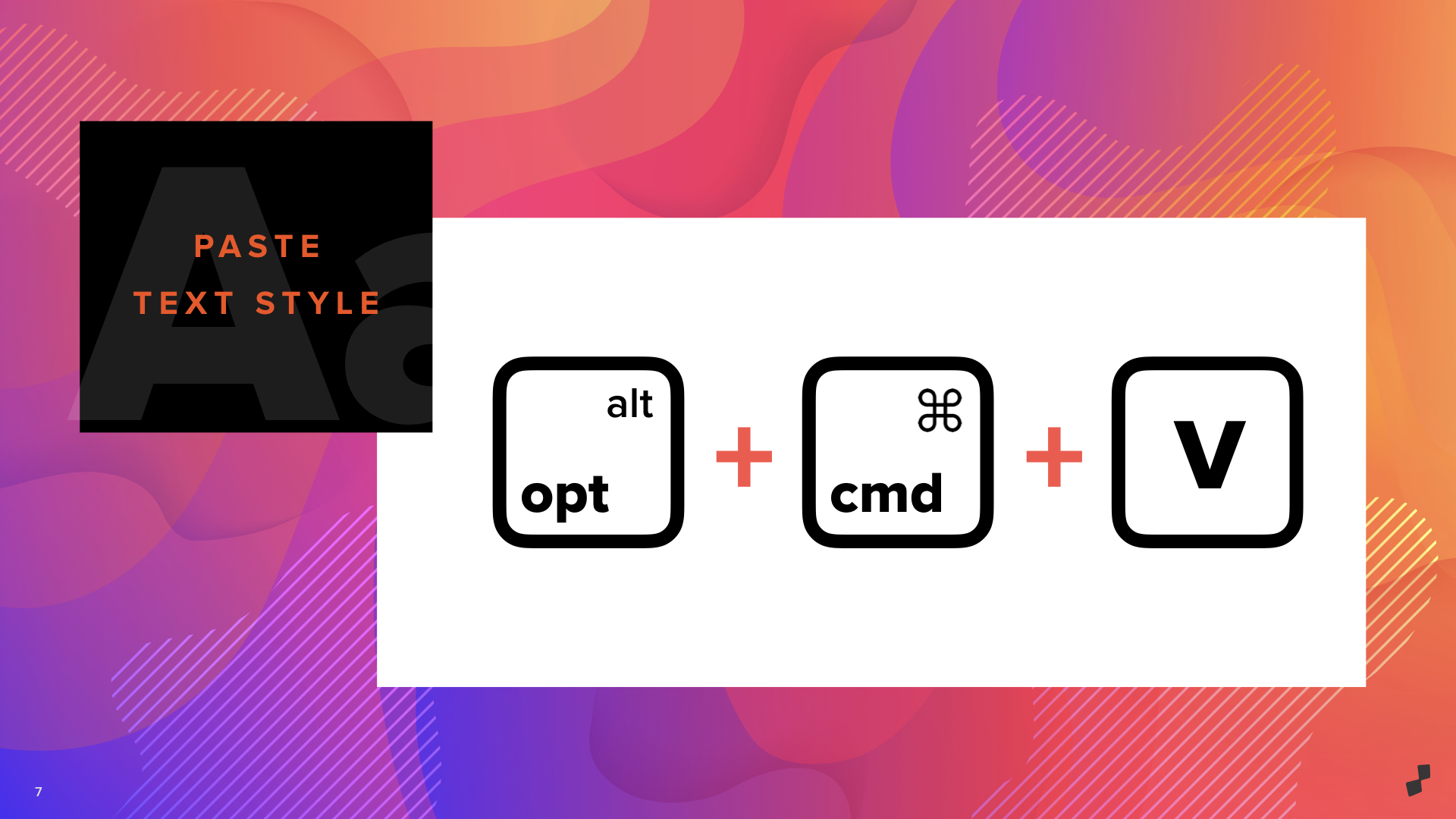
10 Simple Keynote Shortcuts You Wish You Knew Sooner

Most people either love or hate making slide decks. My theory is that if you hate it, it's likely that you haven’t mastered the program just yet. It's estimated that most people lose an average of 2 seconds per minute of work by switching back and forth from their mouse instead of using the designated keyboard shortcut. For example, to open a new tab in a web browser, most people will:1. Move their hand to the mouse2. Then move the cursor to the [+] button to the right of their other open tabs3. Then click that button4. Then switch their hands back to the keyboard to type a search term or URL.
Yet opening a new browser tab could be done much more quickly by simply typing the keys [cmd] + [t]. Learning this single shortcut could save you several cumulative hours over the course of a year. Just to put things into perspective, let's assume you waste an average of 2 seconds per minute each workday...
(2 wasted sec / min) x (480 min / workday) x (240 workdays / year) = 64 wasted hours each year.
That’s 8 workdays wasted per year. Yikes.
I use the example of a browser tab flow because we’re all too familiar with how it’s used. But what you might not realize is that as easy-to-use as Keynote is deemed to be, its Format Pane alone can be unexpectedly tedious to navigate, especially if you’re not using master templates or keynote themes. I find that you often need 3-6 clicks per basic action because it relies on nested tabs and collapsable menus rather than an adaptive properties menu. Three clicks may not sound like a lot, but remember that you're likely making a hundred or more actions per slide deck design, which adds up fast!
Start to improve your workflow by integrating these 10 easy shortcuts into your next Keynote presentation. Challenge yourself to use these often and they’ll become second nature in no time :).

When working with fonts in Keynote, text size doesn’t always have one-size fits all solution. More often than not, you’ll find yourself wanting to tweak it to correct line breaks or prevent orphans. Although [cmd] + [+] and [cmd] + [-] are typically used for zooming in and out in other programs like Google Chrome and the Adobe suite, Apple programs such as Keynote and other built-in applications like Notes use it for font resizing. In Keynote, it’s most handy for small font changes and perfecting layouts, so you may want to use the Format Pane for large-increment sizing edits.

You'll notice that most shortcuts have a pretty intuitive system in place for their counterparts. For instance, if [cmd] + [+] is for increasing text size, it's pretty reasonable to assume that [cmd] + [-] will decrease text size. Keeping this in mind while learning your shortcuts will make the process much quicker.

Commonly used across most text editing programs, [cmd] + [k] is the fastest way to add a link to an image, line of text, or text box. Simply select or highlight the item you want to turn into a clickable element and tap the shortcut key. You’ll then be prompted to paste in a URL. Alternatively, you can choose to link to a different slide or link it to an email address. Once you start using this shortcut, you may find that you get hooked on adding links everywhere. It’s a great way to cite sources or cross-link to assets and other useful information.

Save yourself a few clicks by selecting a slide thumbnail or any element on the slide itself and hit [cmd] + [d] to duplicate it. It’s a huge time saver when recycling slide layouts. One thing to note is that when duplicating an element on a slide (such as an image or text), Keynote will automatically paste it 10 units to the right and down from the original. If you’d like to re-align it to its original placement, simply select the duplicate object and hit [shift] + [up arrow] and then [shift] + [left arrow].

If you work as I do, you may find that you’re frequently adjusting the rag on your text after roughing out a presentation outline. This late-stage finessing can be a huge time suck, so use shortcuts for the most common rags like left aligned text [cmd] + [ { ] and center aligned text [cmd] + [ | ].

An easy way to remember this set of short cuts is that the curly brackets point left for left rag ( { ) and right for right rag ( } ). There's your intuitive pattern for opposites! Now just visualize the pipe ( | )as pointing to no one because it's so damn self-centered ;).

If you find yourself copying content over from multiple documents, online sources, or even notes, you’ll run into a plethora of inconsistent formatting issues when pasting into your final slide deck. A simple way to skip the headache is to copy content over as usual and simply paste it into your slides using the [opt] + [cmd] + [v] operation and it Keynote will match your fonts, colors, and sizes to the existing destination’s text box style.

If you’re trying to maintain a look from a different slide deck, you can also copy existing text styles so that they carry over to your working Keynote file. This will keep you from having to dig through the settings of the Format Pane more than you have to.

Whether you do discovered it accidentally or are an avid abuser of the zooming functionality, being able to reset back to 100% is key. As you may know, you can zoom in or out of a slide using your mouse's scroll wheel or by pinching and zooming on your track pad. To return to 100%, simply hit [cmd] + [0].

I challenge you to practice composing and editing text without having to reach for your mouse! By using [cmd] + [right arrow], you can quickly jump your cursor to the right end of the text box. Try this with any arrow key. For example, the up arrow takes you to the top of the text box, and the down arrow drops it to the very bottom.
Hungry for more time-saving shortcuts or want to make a printable cheatsheet? Explore the full list of Keynote shortcuts from Apple.
Go forth my fellow speed demons!

